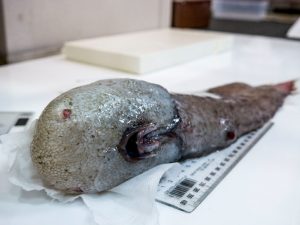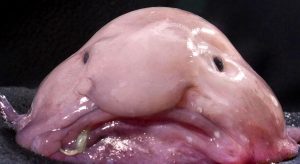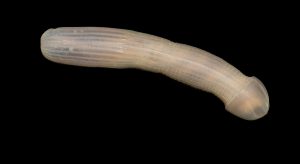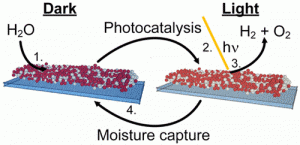A couple of different science stories have gotten a bit of notice this past week, both originating in the nation of Australia. The items are very different but I’m going to combine them.
First up, a team of ocean biologists from the Museums Victoria in Australia have conducted a month long exploration of the deep waters around their island continent. Led by Dr. Tim O’Hara the team of 58 scientists succeeded in bringing back hundreds of specimens of strange creatures from the ocean’s floor, many of them never seen before.
One creature, that had first been discovered back in 1873 but has been unseen ever since, was a ‘Faceless Fish’, a creature without eyes and whose mouth is hidden underneath its head. The picture below shows this ‘Faceless Fish’.

Among the other bizarre creatures the Australian team found were a ‘cookie cutter shark’, which is bioluminescent with serrated teeth, a red spiny crab and the blob fish, know as the world’s ugliest animal. The blob fish is shown in the picture below.

The team of scientists also carried out a survey of the amount of human produced trash that was accumulating on the ocean floor. Even 100 kilometers off the Australian coast the team of researchers discovered PVC pipes, bottles and beer cans along with paint cans, 200 years of rubbish.
Right now the scientists are studying their finds so we will have to wait a while before we know exactly how many new species were discovered. If you’d like to read more about the expedition click on the link below to go to the National Geographic’s webpage.
http://www.nationalgeographic.com.au/australia/australias-freaky-deep-sea-creatures.aspx
Before I go to my next story I’d like to add a picture of a ‘peanut worm’ brought back by the explorers. When you see it I’m certain you’ll know why it’s getting a lot of attention.

The next topic I’d like to discuss concerns the development of ‘Solar Paint’ at the Royal Melbourne Institute of Technology. A team of chemists led by principle author Torben Daeneke has succeeded in producing a paint that is a combination of the white colour in toothpaste with a molybdenum sulphide catalyst. This paint absorbs water vapour from the air during the night and then uses the energy of the Sun to break the absorbed water into Oxygen and Hydrogen during the day. The picture below shows a simplified diagram of the process.

The Hydrogen released by the process can then be used in either a fuel cell to produce electricity or burning in an engine to provide motion. The nice thing about using hydrogen as a fuel is that the only exhaust you get is water! No pollution of any kind!
Now I have to admit I have a little problem with this invention. Since the paint absorbs moisture during the night it must be open to the air. But then during the day it must be contained in order to collect the released hydrogen. In order to make this process commercially valuable you’re going to need a lot of area to be covered by the paint, you know, roof tops and similar setups. These areas will have to be exposed to the air during the night but covered in some way during the day to collect the produced hydrogen.
Now I can certainly think of ways to accomplish that but over the large areas? I’m afraid it could end up being both complicated and expensive.
Still Doctor Daeneke believes that ‘solar paint’ will become available in about five years and he also believes the paint itself will be rather cheap making ‘solar paint’ a useful source of clean energy. If you’d like to read more about ‘solar paint’ click on the link below.
https://www.inverse.com/article/32976-solar-paint-hydrogen-energy
So there you have a taste of the kind of science being accomplished by our southern friends. Anytime I hear about some new discovery from down under I’ll be sure to tell you all about it.
